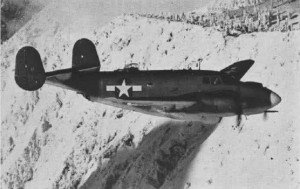![]() The Pacific War Online Encyclopedia
The Pacific War Online Encyclopedia
|
| Previous: PV-1 Ventura, U.S. Patrol Bomber | Table of Contents | Next: Pye, William S. |

U.S.Navy. Via Wikipedia
Commons
Lockheed PV-2 Harpoon
| Crew | 4 or 5 |
|
Dimensions |
75'0" by 52'0" by 13'3" 22.86m by 15.85m by 4.04m |
|
Weight |
21,028-36,000 lbs 9538-16,000 kg |
|
Speed |
271 mph (436 km/h) at sea level 282 mph (454 km/h) at13,700 feet |
|
Cruising speed |
171 mph 275 km/h |
| Rate of climb | 27 feet per second 8.2 meters per second |
|
Ceiling |
23,900 feet 7280 meters |
| 2 2000 hp (1491 kW) Pratt & Whitney R-2800-31 Double Wasp 18-cylinder radials driving three bladed propellers. | |
|
Armament |
5 nose 0.50
machine guns Dual 0.50 machine gun nose turret Dual 0.50 machine gun dorsal turret Two ventral 0.50 machine guns |
|
External Stores |
One torpedo or 4000
lbs (1800 kg) bombs internal 2000 lbs (900 kg) under wings, including rocket projectiles |
|
Range |
Normal 1790 miles (2880 km) Maximum 2930 miles (4720 km) |
|
Production |
From March 1944: 500 PV-2 35 PV-2D |
| Variants | The PV-2D had eight 0.50 machine guns in the nose but was not ready in time for combat. |
The Harpoon was a development of the Ventura
that inherited the
designator and most of the features. However, it had a redesigned
empennage, greater wing area and larger fuel tanks, enhanced nose
armament, and a significantly greater ordinance capacity for the
antishipping role.
The new design was requested in June 1943 and the first prototype
flew on 3 December 1943. Deliveries began three months later, but the
first 30 units had defective fuel tanks and were used only for training.
Most operated in the Pacific during the last year of the war.
References
The Pacific War Online Encyclopedia © 2007, 2010 by Kent G. Budge. Index